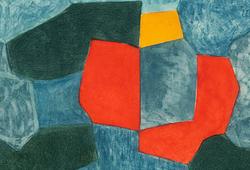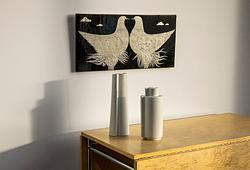Antoni Tàpies
"Signe gris".
Signed Tàpies verso. Executed in 1981. Paint on lava, 26.5 x 36 cm.
Provenance
Galerie Maeght, Paris.
Galerie Lelong, Paris.
Acquired by the present owner from the above in 2006.
Literature
Anna Agustí, "Tàpies. Obra Completa. Volumen 4, 1976 - 1981", p. 415, cat. no. 4119.
More information
Antoni Tàpies was born in 1923 in Barcelona. His family belonged to the affluent Catalan middle class, and his interest in history, literature, and politics was awakened early on. His grandfather was politically engaged, and the political awareness he gained in his childhood significantly influenced a large part of his artistic production, along with his deep interest in poetry and philosophy. Tàpies suffered from a lung ailment during his youth, which forced him to spend long periods in sanatoriums outside the city. It was during these breaks from Barcelona's bustling atmosphere that Tàpies discovered the joy of drawing and painting. He also read copious amounts of philosophical literature and acquainted himself with authors such as Proust, Stendhal, Nietzsche, Ibsen, and Thomas Mann, to name a few. The Spanish Civil War plagued the country from 1936 to 1939, resulting in Franco's rise to power in the same year that World War II began. All of this occurred during the formative years of the artist and must have been decisive for his continued path and the expression that his creative work resulted in. In 1943, after three years of legal studies, Tàpies decided to wholeheartedly dedicate himself to art.
The works created in the mid-1940s leaned towards both expressiveness and primitivism. Even in this very early production, a common thread can be found in his interest in materials, grattage, and the possibilities of collage techniques. Tàpies' art was first exhibited in 1948 at the then-controversial Salo d'Octubre, at Galeries Laietanes in Barcelona. It was during this time that he met Joan Miró, leading to a lifelong friendship. Over the following years, Tàpies created a series of works with a surrealistic spirit, inspired by Miró and Paul Klee. Two years later, he returned with a solo exhibition at the same gallery, and his art had an immediate impact. Subsequently, numerous exhibitions followed throughout Europe, and in 1953, his art was introduced to the American audience through a solo exhibition at the legendary Martha Jackson Gallery in New York, marking the beginning of his significant success with an expanding art audience.
Tàpies' focus on the material and the spiritual aspect of the art experience made him a leading figure, and he gained numerous followers. In the 1960s, he increasingly incorporated iconographic elements into his paintings. Not only did he blend sand, soil, and textiles, but he also allowed words and symbols to occupy space, dissolving the distinction between the purely literary and the purely visual. This is one of his greatest strengths, and based on this, Tàpies has been able to continue exploring his very personal synthesis of words and images. In the early 1980s, Tàpies experimented with refractory clay, as seen in the auction's "Signe gris" from 1981.

























